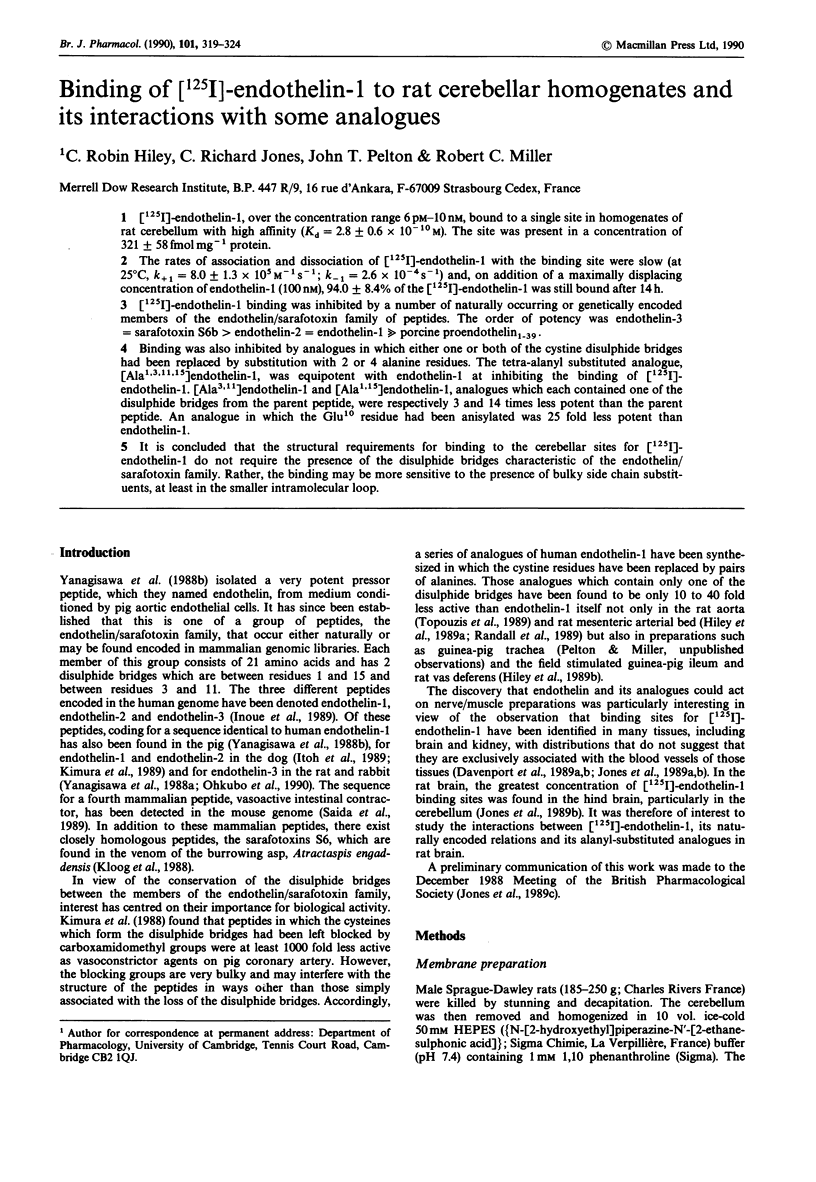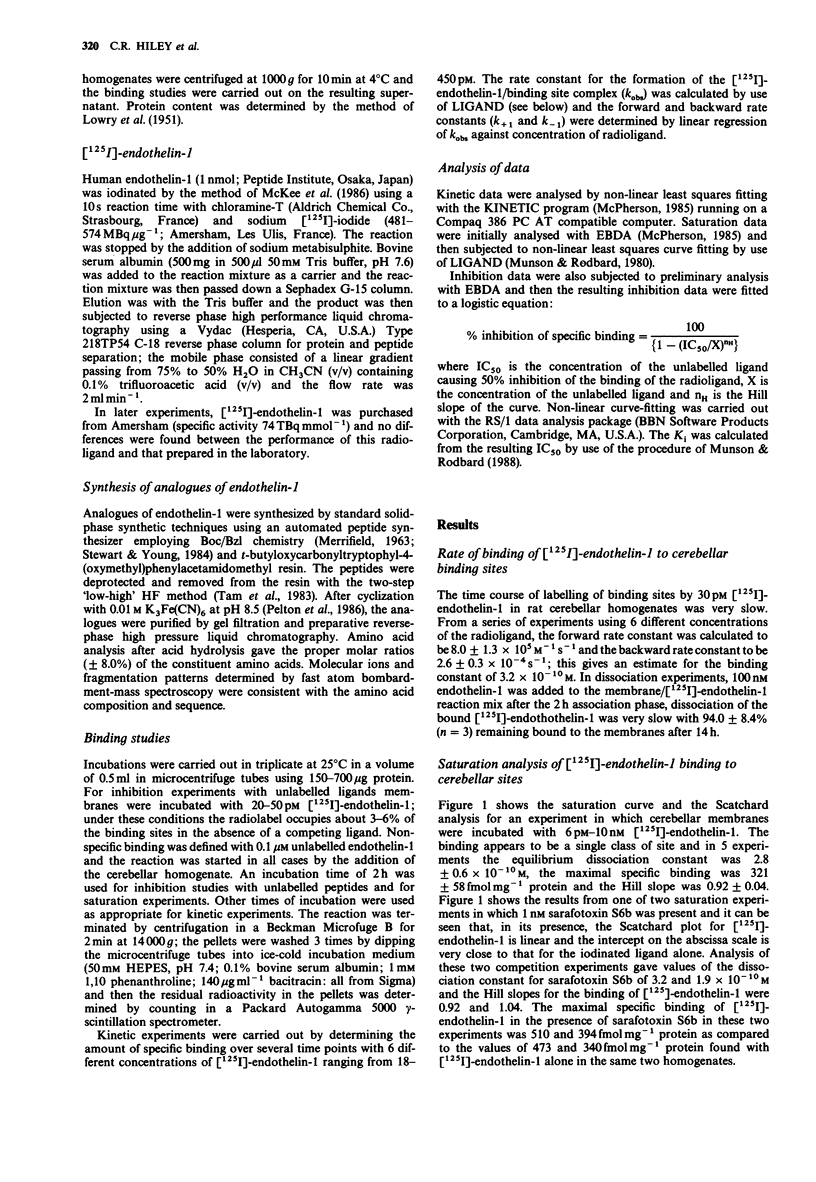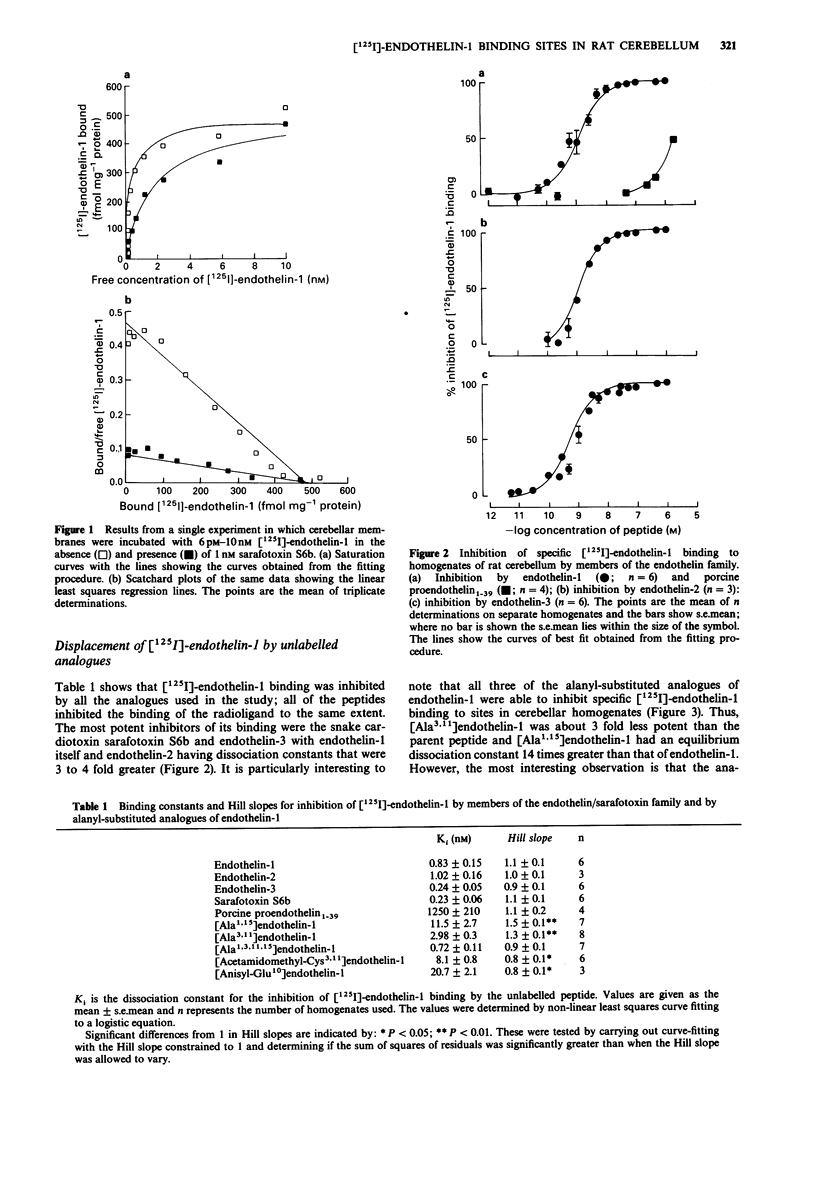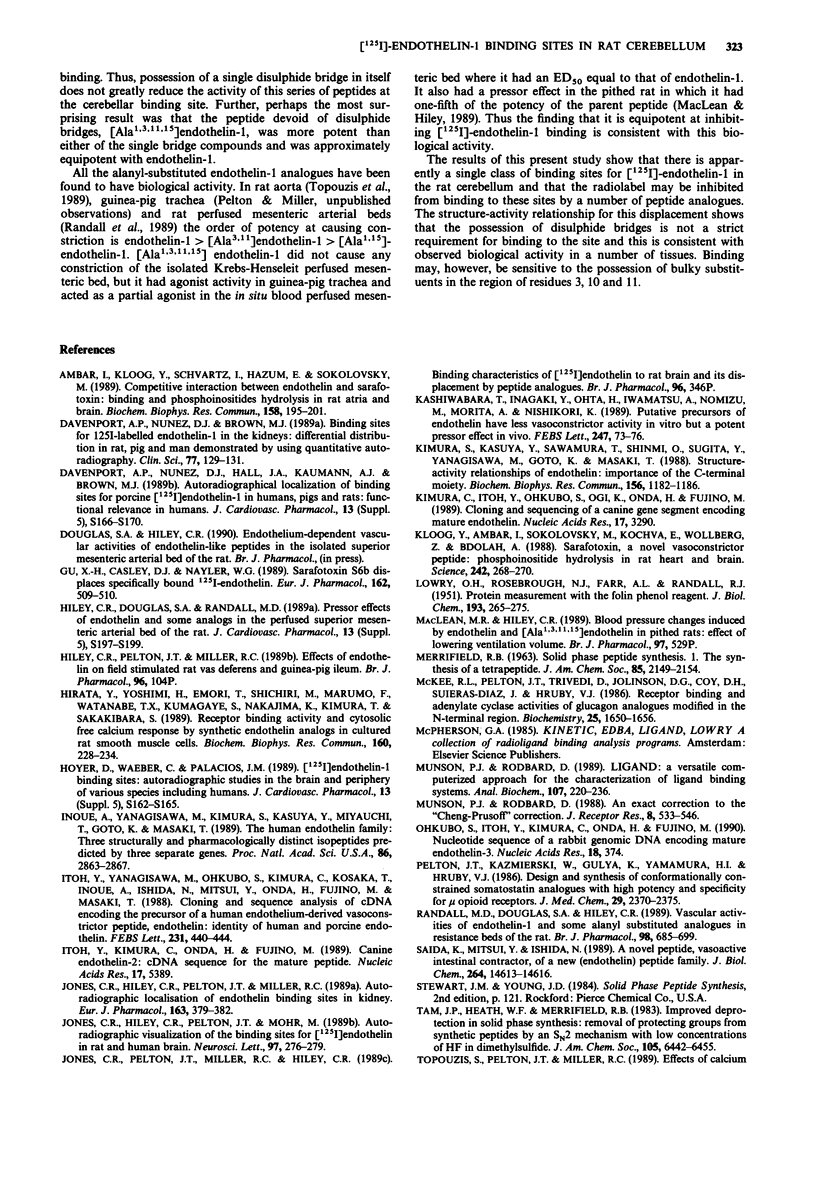Abstract
1. [125I]-endothelin-1, over the concentration range 6 pM-10 nM, bound to a single site in homogenates of rat cerebellum with high affinity (Kd = 2.8 +/- 0.6 x 10(-10) M). The site was present in a concentration of 321 +/- 58 fmol mg-1 protein. 2. The rates of association and dissociation of [125I]-endothelin-1 with the binding site were slow (at 25 degrees C, k+1 = 8.0 +/- 1.3 x 10(5) M-1s-1; k-1 = 2.6 x 10(-4)s-1) and, on addition of a maximally displacing concentration of endothelin-1 (100 nM), 94.0 +/- 8.4% of the [125I]-endothelin-1 was still bound after 14 h. 3. [125I]-endothelin-1 binding was inhibited by a number of naturally occurring or genetically encoded members of the endothelin/sarafotoxin family of peptides. The order of potency was endothelin-3 = sarafotoxin S6b greater than endothelin-2 = endothelin-1 much greater than porcine proendothelin1-39. 4. Binding was also inhibited by analogues in which either one or both of the cystine disulphide bridges had been replaced by substitution with 2 or 4 alanine residues. The tetra-alanyl substituted analogue, [Ala1,3,11,15]endothelin-1, was equipotent with endothelin-1 at inhibiting the binding of [125I]-endothelin-1. [Ala3,11]endothelin-1 and [Ala1,15]endothelin-1, analogues which each contained one of the disulphide bridges from the parent peptide, were respectively 3 and 14 times less potent than the parent peptide. An analogue in which the Glu10 residue had been anisylated was 25 fold less potent than endothelin-1.(ABSTRACT TRUNCATED AT 250 WORDS)
Full text
PDF





Selected References
These references are in PubMed. This may not be the complete list of references from this article.
- Ambar I., Kloog Y., Schvartz I., Hazum E., Sokolovsky M. Competitive interaction between endothelin and sarafotoxin: Binding and phosphoinositides hydrolysis in rat atria and brain. Biochem Biophys Res Commun. 1989 Jan 16;158(1):195–201. doi: 10.1016/s0006-291x(89)80197-4. [DOI] [PubMed] [Google Scholar]
- Davenport A. P., Nunez D. J., Brown M. J. Binding sites for 125I-labelled endothelin-1 in the kidneys: differential distribution in rat, pig and man demonstrated by using quantitative autoradiography. Clin Sci (Lond) 1989 Aug;77(2):129–131. doi: 10.1042/cs0770129. [DOI] [PubMed] [Google Scholar]
- Davenport A. P., Nunez D. J., Hall J. A., Kaumann A. J., Brown M. J. Autoradiographical localization of binding sites for porcine [125I]endothelin-1 in humans, pigs, and rats: functional relevance in humans. J Cardiovasc Pharmacol. 1989;13 (Suppl 5):S166–S170. doi: 10.1097/00005344-198900135-00045. [DOI] [PubMed] [Google Scholar]
- Gu X. H., Casley D. J., Nayler W. G. Sarafotoxin S6b displaces specifically bound 125I-endothelin. Eur J Pharmacol. 1989 Mar 29;162(3):509–510. doi: 10.1016/0014-2999(89)90342-7. [DOI] [PubMed] [Google Scholar]
- Hiley C. R., Douglas S. A., Randall M. D. Pressor effects of endothelin-1 and some analogs in the perfused superior mesenteric arterial bed of the rat. J Cardiovasc Pharmacol. 1989;13 (Suppl 5):S197–S199. doi: 10.1097/00005344-198900135-00055. [DOI] [PubMed] [Google Scholar]
- Hirata Y., Yoshimi H., Emori T., Shichiri M., Marumo F., Watanabe T. X., Kumagaye S., Nakajima K., Kimura T., Sakakibara S. Receptor binding activity and cytosolic free calcium response by synthetic endothelin analogs in cultured rat vascular smooth muscle cells. Biochem Biophys Res Commun. 1989 Apr 14;160(1):228–234. doi: 10.1016/0006-291x(89)91645-8. [DOI] [PubMed] [Google Scholar]
- Hoyer D., Waeber C., Palacios J. M. [125I]endothelin-1 binding sites: autoradiographic studies in the brain and periphery of various species including humans. J Cardiovasc Pharmacol. 1989;13 (Suppl 5):S162–S165. [PubMed] [Google Scholar]
- Inoue A., Yanagisawa M., Kimura S., Kasuya Y., Miyauchi T., Goto K., Masaki T. The human endothelin family: three structurally and pharmacologically distinct isopeptides predicted by three separate genes. Proc Natl Acad Sci U S A. 1989 Apr;86(8):2863–2867. doi: 10.1073/pnas.86.8.2863. [DOI] [PMC free article] [PubMed] [Google Scholar]
- Itoh Y., Kimura C., Onda H., Fujino M. Canine endothelin-2: cDNA sequence for the mature peptide. Nucleic Acids Res. 1989 Jul 11;17(13):5389–5389. doi: 10.1093/nar/17.13.5389. [DOI] [PMC free article] [PubMed] [Google Scholar]
- Itoh Y., Yanagisawa M., Ohkubo S., Kimura C., Kosaka T., Inoue A., Ishida N., Mitsui Y., Onda H., Fujino M. Cloning and sequence analysis of cDNA encoding the precursor of a human endothelium-derived vasoconstrictor peptide, endothelin: identity of human and porcine endothelin. FEBS Lett. 1988 Apr 25;231(2):440–444. doi: 10.1016/0014-5793(88)80867-6. [DOI] [PubMed] [Google Scholar]
- Jones C. R., Hiley C. R., Pelton J. T., Miller R. C. Autoradiographic localisation of endothelin binding sites in kidney. Eur J Pharmacol. 1989 Apr 25;163(2-3):379–382. doi: 10.1016/0014-2999(89)90211-2. [DOI] [PubMed] [Google Scholar]
- Jones C. R., Hiley C. R., Pelton J. T., Mohr M. Autoradiographic visualization of the binding sites for [125I]endothelin in rat and human brain. Neurosci Lett. 1989 Feb 27;97(3):276–279. doi: 10.1016/0304-3940(89)90610-1. [DOI] [PubMed] [Google Scholar]
- Kashiwabara T., Inagaki Y., Ohta H., Iwamatsu A., Nomizu M., Morita A., Nishikori K. Putative precursors of endothelin have less vasoconstrictor activity in vitro but a potent pressor effect in vivo. FEBS Lett. 1989 Apr 10;247(1):73–76. doi: 10.1016/0014-5793(89)81243-8. [DOI] [PubMed] [Google Scholar]
- Kimura C., Itoh Y., Ohkubo S., Ogi K., Onda H., Fujino M. Cloning and sequencing of a canine gene segment encoding mature endothelin. Nucleic Acids Res. 1989 Apr 25;17(8):3290–3290. doi: 10.1093/nar/17.8.3290. [DOI] [PMC free article] [PubMed] [Google Scholar]
- Kimura S., Kasuya Y., Sawamura T., Shinmi O., Sugita Y., Yanagisawa M., Goto K., Masaki T. Structure-activity relationships of endothelin: importance of the C-terminal moiety. Biochem Biophys Res Commun. 1988 Nov 15;156(3):1182–1186. doi: 10.1016/s0006-291x(88)80757-5. [DOI] [PubMed] [Google Scholar]
- Kloog Y., Ambar I., Sokolovsky M., Kochva E., Wollberg Z., Bdolah A. Sarafotoxin, a novel vasoconstrictor peptide: phosphoinositide hydrolysis in rat heart and brain. Science. 1988 Oct 14;242(4876):268–270. doi: 10.1126/science.2845579. [DOI] [PubMed] [Google Scholar]
- LOWRY O. H., ROSEBROUGH N. J., FARR A. L., RANDALL R. J. Protein measurement with the Folin phenol reagent. J Biol Chem. 1951 Nov;193(1):265–275. [PubMed] [Google Scholar]
- McKee R. L., Pelton J. T., Trivedi D., Johnson D. G., Coy D. H., Sueiras-Diaz J., Hruby V. J. Receptor binding and adenylate cyclase activities of glucagon analogues modified in the N-terminal region. Biochemistry. 1986 Apr 8;25(7):1650–1656. doi: 10.1021/bi00355a031. [DOI] [PubMed] [Google Scholar]
- Munson P. J., Rodbard D. An exact correction to the "Cheng-Prusoff" correction. J Recept Res. 1988;8(1-4):533–546. doi: 10.3109/10799898809049010. [DOI] [PubMed] [Google Scholar]
- Munson P. J., Rodbard D. Ligand: a versatile computerized approach for characterization of ligand-binding systems. Anal Biochem. 1980 Sep 1;107(1):220–239. doi: 10.1016/0003-2697(80)90515-1. [DOI] [PubMed] [Google Scholar]
- Ohkubo S., Itoh Y., Kimura C., Onda H., Fujino M. Nucleotide sequence of a rabbit genomic DNA encoding mature endothelin-3. Nucleic Acids Res. 1990 Jan 25;18(2):374–374. doi: 10.1093/nar/18.2.374. [DOI] [PMC free article] [PubMed] [Google Scholar]
- Pelton J. T., Kazmierski W., Gulya K., Yamamura H. I., Hruby V. J. Design and synthesis of conformationally constrained somatostatin analogues with high potency and specificity for mu opioid receptors. J Med Chem. 1986 Nov;29(11):2370–2375. doi: 10.1021/jm00161a037. [DOI] [PubMed] [Google Scholar]
- Randall M. D., Douglas S. A., Hiley C. R. Vascular activities of endothelin-1 and some alanyl substituted analogues in resistance beds of the rat. Br J Pharmacol. 1989 Oct;98(2):685–699. doi: 10.1111/j.1476-5381.1989.tb12644.x. [DOI] [PMC free article] [PubMed] [Google Scholar]
- Saida K., Mitsui Y., Ishida N. A novel peptide, vasoactive intestinal contractor, of a new (endothelin) peptide family. Molecular cloning, expression, and biological activity. J Biol Chem. 1989 Sep 5;264(25):14613–14616. [PubMed] [Google Scholar]
- Topouzis S., Pelton J. T., Miller R. C. Effects of calcium entry blockers on contractions evoked by endothelin-1, [Ala3,11]endothelin-1 and [Ala1,15]endothelin-1 in rat isolated aorta. Br J Pharmacol. 1989 Oct;98(2):669–677. doi: 10.1111/j.1476-5381.1989.tb12642.x. [DOI] [PMC free article] [PubMed] [Google Scholar]
- Yanagisawa M., Inoue A., Ishikawa T., Kasuya Y., Kimura S., Kumagaye S., Nakajima K., Watanabe T. X., Sakakibara S., Goto K. Primary structure, synthesis, and biological activity of rat endothelin, an endothelium-derived vasoconstrictor peptide. Proc Natl Acad Sci U S A. 1988 Sep;85(18):6964–6967. doi: 10.1073/pnas.85.18.6964. [DOI] [PMC free article] [PubMed] [Google Scholar]
- Yanagisawa M., Kurihara H., Kimura S., Tomobe Y., Kobayashi M., Mitsui Y., Yazaki Y., Goto K., Masaki T. A novel potent vasoconstrictor peptide produced by vascular endothelial cells. Nature. 1988 Mar 31;332(6163):411–415. doi: 10.1038/332411a0. [DOI] [PubMed] [Google Scholar]


